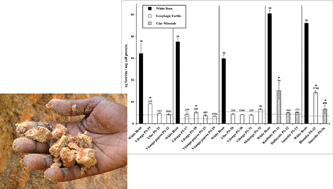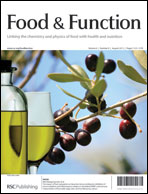Bioavailability of iron in geophagic earths and clay minerals, and their effect on dietary iron absorption using an in vitro digestion/Caco-2 cell model
Abstract
Geophagy, the deliberate consumption of earth, is strongly associated with iron (Fe) deficiency. It has been proposed that geophagy may be practiced as a means to improve Fe status by increasing Fe intakes and, conversely, that geophagy may cause Fe deficiency by inhibiting Fe absorption. We tested these hypotheses by measuring Fe concentration and relative bioavailable Fe content of 12 samples of geophagic earth and 4 samples of pure clay minerals. Further, we assessed the impact of these samples on the bioavailability of Fe from an Fe-rich test meal (cooked white beans, WB). Fe concentrations were measured with inductively coupled plasma atomic emission spectroscopy. Fe bioavailability was determined using an in vitro digestion/Caco-2 cell model in which ferritin formation was used as an index of Fe bioavailability. Geophagic earth and clay mineral samples were evaluated with this model, both alone and in combination with WB (1 : 16 ratio, sample : WB). Median Fe concentration of the geophagic earth was 3485 (IQR 2462, 14 571) μg g−1 and mean Fe concentration in the clay minerals was 2791 (±1782) μg g−1. All specimens had Fe concentrations significantly higher (p ≤ 0.005) than the Fe concentration of WB (77 μg g−1). Ferritin formation (i.e. Fe uptake) in cells exposed to geophagic earths and clay minerals was significantly lower than in cells exposed to WB (p ≤ 0.05) and Fe uptake responses of 11 of the 16 samples were not significantly different from the blank, indicating no bioavailable Fe. When samples were combined with WB, 5 of 16 had mean ferritin levels that were significantly lower (p ≤ 0.05, one tail) than the WB alone, indicating that the samples inhibited Fe uptake from the WB. None of the ferritin responses of cells exposed to both WB and earth/clay were significantly higher than WB alone. Thus, although geophagic earths and mineral clays are high in total Fe, very little of this Fe is bioavailable. Further, some geophagic earth and clay mineral samples inhibit Fe absorption from foods. In vivo research is warranted to confirm these observations and to determine if geophagic earth samples can be a source of Fe and/or inhibit Fe absorption.


 Please wait while we load your content...
Please wait while we load your content...